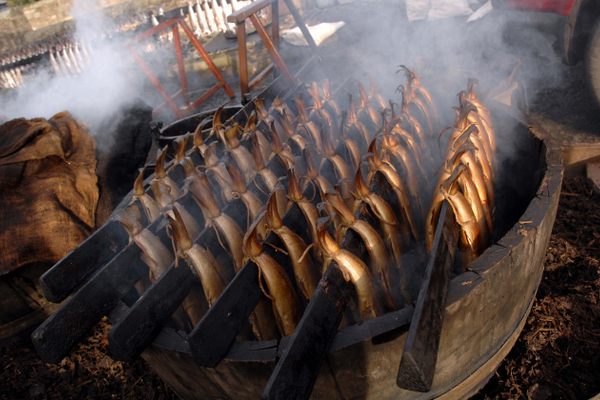In the beer lovers’ paradise of Bamberg, Germany, you’ll find giant piles of beechwood stacked outside some of the city’s breweries. Although wood isn’t usually an ingredient in beer, it is essential to the traditional German style called rauchbier. Just as some single-malt scotches are prized for their peaty essence, rauchbier picks up so much smoky aroma and flavor in the brewing process that some compare it to smoked meat.
If that sounds unusual, that’s because rauchbiers are rare today. But up until the 17th century, most beers contained this smoky essence. After malting their grains (i.e., submerging them in water so they begin to sprout), brewers must dry them. Historically, the only way to do this was by placing the sprouted grains over a fire. Directly roasting over the flames, the malt picked up a distinctive smoky flavor. This remained in the resulting brews, which typically took the form of the rich, reddish-brown lager known as märzen.
After the Industrial Revolution brought new heating technology that allowed brewers to better control the process, breweries steadily adopted the updated methods until only a few traditional holdouts remained in Bamberg. One such holdout is the Schlenkerla brewery. Located in the heart of Bamberg, Schlenkerla sits in the former home of a 13th-century Dominican monastery. Drinkers can sip the brewery’s smoked märzen, bock, or wheat ale in its tavern, a repurposed chapel with original gold leaf paintings still on the ceiling.
Where to Try It
-
Schlenkerla Brewery
Dominikanerstrasse 6, Bamberg, 96049, GermanyTheir cafe is open daily from 9:30 a.m. to 11:30 p.m., with food served from 11:30 a.m. to 10 p.m. Their beer garden is open, weather permitting, from Easter till early October.
-
Black Husky Brewing
909 E. Locust St, Milwaukee, Wisconsin, 53212, United StatesRauchbier isn’t a super popular style with American craft breweries, but you can sometimes find it at this Milwaukee brewery.
Written By
D Diane McMartinSources
- www.atlasobscura.com/articles/all-beer-tasted-like-smoke-brewing
- www.schlenkerla.de/rauchbier/beschreibunge.html
- www.fondazioneslowfood.com/en/ark-of-taste-slow-food/bamberga-rauchbier/
- books.google.com/books?id=Ga4MYyZq-RMC&printsec=frontcover&dq=oxford+companion+to+beer+rauchbier&hl=en&sa=X&ved=0ahUKEwjfhdjd1JfdAhWST98KHcakBeIQ6AEIJzAA#v=onepage&q=%20rauchbier&f=false
- books.google.com/books?id=twkRFn75VAEC&pg=PA179&dq=mosher+rauchbier&hl=en&sa=X&ved=0ahUKEwjJrYCR1ZfdAhVHON8KHTaTDQEQ6AEIRTAF#v=onepage&q=mosher%20rauchbier&f=false
The Atlas Obscura Podcast is Back!















